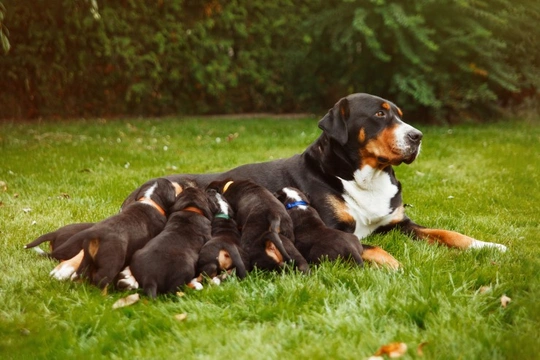
Dog Breeding Season: Heat Cycles & Mating
If you own a good quality pedigree bitch that you intend to keep unspayed so that you can breed from her, it is important to have a good understanding of heat cycles in the dog. Any time that your bitch comes into heat, she will be receptive to mating and very fertile, and just one mis-mating incident can result in a litter of unwanted puppies.
If you don’t wish to breed from your bitch, the smart decision is to have her neutered to prevent her from mating and solve the often challenging management issues that heat cycles in dogs can cause, and this is something you should discuss with your vet at the first opportunity.
Whether you already own an unspayed bitch or are planning to get one – or keep your female puppy unspayed so that you can decide later on if you want to breed from her – you need to understand when and why she will come into heat.
In this article we will explain when bitches come into heat, and the times of year that dogs are most fertile and receptive to mating. Read on to learn more.
When do young female dogs first come into heat?
The age at which young female dogs first undergo a heat cycle can be very variable, and this is often partially dictated by the dog’s breed and size. Large and giant dog breeds tend to undergo their first heat cycle much later than smaller breeds, as large breeds take longer to fully mature and grow to their adult size in general.
Many small and toy dog breeds will have their first heat cycle as early as six months of age, and across the board, most young female dogs will have their first heat cycle between six months and one year old.
However, for large breeds, it can take as long as two years or even sometimes more before the dog has matured enough to undergo their first heat cycle, and this is perfectly normal. That said, if your dog hasn’t undergone a heat cycle by the time they are around 18 months old for large breeds and a year old for smaller breeds, you might want to ask your vet to give them a check up to ensure that everything is working properly.
How often do bitches come into heat?
Most fertile adult bitches will come into heat just once or twice a year, about six months apart. However, small and toy breeds may even go through three heat cycles a year, and for very large and giant breeds, you may find just one heat cycle a year – or even one every 18 months.
This means that planning for a litter is something that requires work, as you will need to be able to chart your bitch’s heat cycles and know when she is likely to come into heat and so, be receptive to breeding. Charting your bitch’s heat cycles is equally important to ensure that your bitch doesn’t breed with a dog you don’t want them to when you’re not planning a litter with a chosen sire!
What makes dogs come into heat?
Some species of mammals (including cats, to some extent) can have the onset of a heat cycle triggered by the presence of a fertile male, which sends out hormonal signals to the female and actually causes the onset of a heat cycle. However, this isn’t thought to be true for dogs, who have fairly regular heat cycles that can usually be predicted with a reasonable degree of accuracy once the bitch is fully grown.
Generally, if your bitch comes into heat a couple of times a year during a certain month for their first couple of heat cycles, they are likely to repeat this pattern fairly closely throughout the rest of their fertile life.
Do dogs have a breeding season?
When it comes to the times of year that bitches are most likely to come into heat, this tends to happen during the warmer months of the year – any time from the first signs of spring through to late autumn. Most bitches that have two heat cycles a year will have one in spring and one in autumn.
This means that spring, summer and autumn are the times of year when the majority of litters are born – generally being spring and summer. Winter litters are rather rarer, and every year, more pups are born in spring and summer than at other times of the year.
Dogs have evolved with this fairly broadly set breeding season for a reason – because in the wild, delivering young in the milder months of the year gives them a better chance of surviving and thriving.
The warmer months of the year mean that food is more readily available and easier to find, and the weather is not so harsh that it may pose a risk to the pups’ survival. Even though our domestic dogs are provided with food year-round and benefit from care and warmth in the home regardless of the weather, dogs have largely maintained the evolutionary trait of coming into heat and so, breeding at the times of year that result in litters being born when the weather is mild.
This is why you will usually see many more adverts for young puppies for sale on Pets4Homes in the spring and summer than you will during the winter and to some extent, autumn.



